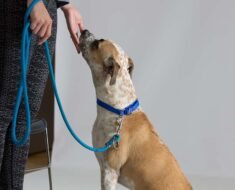Training your dog to heel beside your bicycle can make every ride safer and more enjoyable for both of you. But rushing into it without the right steps can lead to frustration—or worse, accidents.
What if you could teach your dog to stay calm and close, no matter how fast you pedal? This guide will show you exactly how to train your dog to heel beside your bike using simple, gradual steps. By the end, you’ll have the confidence to ride together safely and happily.
Ready to transform your biking experience? Let’s get started.
Preparing Your Dog For Biking
Choosing the right equipmentis key for safe bike rides with your dog. Use a sturdy leashand a comfortable harness. Avoid collars that can hurt your dog’s neck. A bike leash attachment keeps your hands free and controls your dog better.
Assessing your dog’s fitnesshelps prevent injuries. Start with short walks to build stamina. Watch for signs of tiredness or discomfort. Dogs with health issues should see a vet before biking.
Basic obedience skillsare needed to keep control. Your dog must know commands like heel, stop,and wait. Practice these on walks before biking. This makes the ride safer and more fun for both of you.
Introducing The Bicycle Slowly
Start by letting your dog see and sniff the bicycle while it is still. This helps your dog feel safeand curiousabout the bike. Let the dog explore without pressure.
Next, walk slowly beside the bike. Hold the leash gently and keep the bike steady. Walk at a slow pace to help your dog adjustto moving next to the bicycle. Stop if your dog seems scared or unsure.
Use positive reinforcementlike treats and praise. Reward your dog for calm behavior near the bike. This builds a good feelingabout the bike and walking beside it. Short sessions work best to keep your dog happy.
Teaching The Heel Position
Start by practicing the heel positionin short sessions. Keep each session brief to avoid tiring your dog. Use a calm voice and gentle praise to encourage good behavior.
Use clear commands and hand signalsconsistently. Choose simple words like “heel” and pair them with a hand motion. This helps your dog understand what you want quickly.
Keep your dog’s focus and attentionby minimizing distractions. Practice in quiet places at first. Reward your dog often to keep them interested and attentive.
Practicing With Movement
Start by walking slowlywhile riding your bike. This helps your dog get used to the movement and sounds. Keep the pace easy so your dog feels safe and calm.
Next, gradually increase the speed. Do this in small steps. Watch your dog closely to ensure it stays comfortable and able to keep up. Stop if your dog seems tired or scared.
Practice handling turns and stopscarefully. Use clear signals before turning or stopping. This helps your dog learn when to slow down or change direction. Be patient and give treats for good behavior.
Ensuring Safety Throughout Training
Choose quiet, flat places with few distractions for training. Parks or empty streets work well. These spots help your dog focus and feel safe. Avoid busy roads or areas with loud noises.
Watch your dog’s body language closely. Signs like panting, slowing down, or pulling show they need a break. Stop training if your dog seems scared or tired. Praise good behavior with gentle words and treats.
Keep training sessions short and easy. Start with a few minutes and slowly add time. Overdoing it can make your dog tired or stressed. Rest breaks and water help your dog stay happy and healthy.

Credit: www.athletico.com
Troubleshooting Common Issues
Distractionslike other dogs or noises can break your dog’s focus. Start training in a quiet place. Gradually add small distractions. Reward your dog for staying close to the bike. Keep sessions short and fun.
Fear or anxietymay cause your dog to stop or run away. Stay calm and speak softly. Use treats to create positive feelings. Let your dog explore the bike when it is still. Slowly move the bike to help them get used to it.
Pulling and laggingare common problems. Use a short leash to control your dog better. If your dog pulls, stop moving until they relax. If they lag, encourage them with a cheerful voice. Practice often for steady progress.
Advanced Techniques For Experienced Dogs
Off-leash heel training helps your dog stay close without a leash. Start in a quiet place. Use a long leash first for safety. Reward your dog with treats and praise for staying near. Gradually reduce leash length as your dog improves.
Incorporate obstacles like cones or small jumps during training. This teaches your dog to focus despite distractions. Practice steering around these objects while riding slowly. Keep sessions short to avoid tiring your dog.
Building endurance is key for long rides. Begin with short distances at a slow pace. Increase speed and distance step by step. Watch your dog’s energy and give breaks when needed. Consistent practice helps your dog stay strong and steady.

Credit: pupford.com

Credit: www.eukanuba.com
Frequently Asked Questions
How Do I Start Training My Dog To Heel By A Bicycle?
Begin training in a quiet area with your bike stationary. Use treats and commands to encourage your dog to stay beside you. Gradually introduce slow biking as your dog gains confidence. Patience and consistency are key to success.
What Safety Gear Is Needed When Training A Dog To Bike Heel?
Always use a sturdy leash and a well-fitted harness for control. Wear a helmet yourself for safety. Ensure your bike has reflectors or lights if riding in low light. These precautions protect both you and your dog during training.
How Long Does It Take To Train A Dog To Heel By Bike?
Training time varies by dog’s age and experience. Typically, it takes several weeks of short, regular sessions. Consistent practice and positive reinforcement speed up learning. Always progress at your dog’s comfortable pace to avoid stress.
What Common Mistakes Should I Avoid During Training?
Avoid rushing the process or using harsh commands. Don’t allow your dog to pull ahead or lag behind. Avoid busy roads initially to prevent distractions. Keep training sessions short and positive to maintain your dog’s interest.
Conclusion
Training your dog to heel safely beside a bicycle takes time and care. Start slow, use clear commands, and reward good behavior. Keep practice sessions short and consistent. Watch your dog’s comfort and safety closely at all times. Patience helps build trust and good habits.
Soon, your dog will enjoy riding calmly by your side. Enjoy the journey together, step by step.





